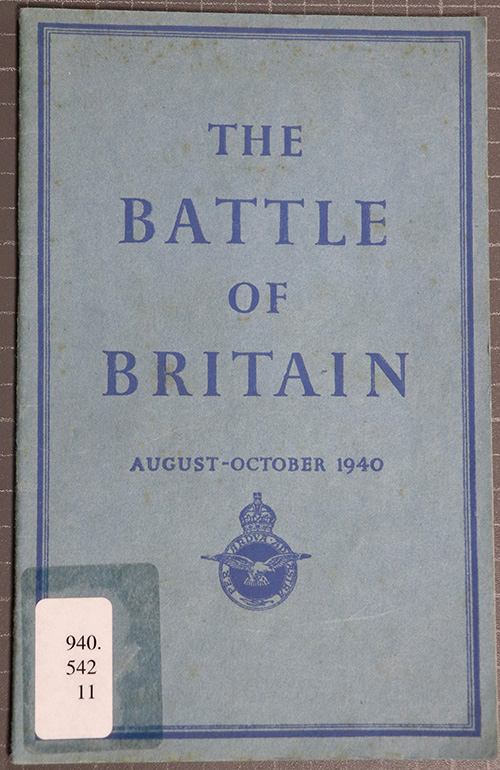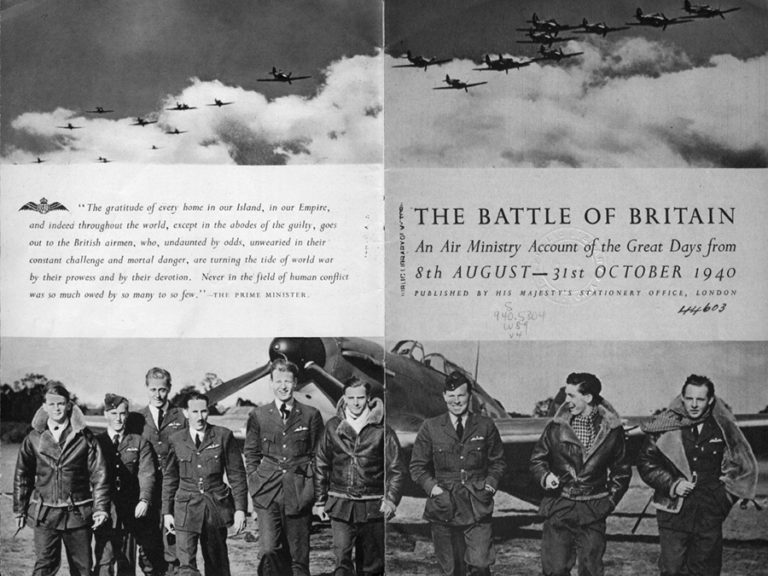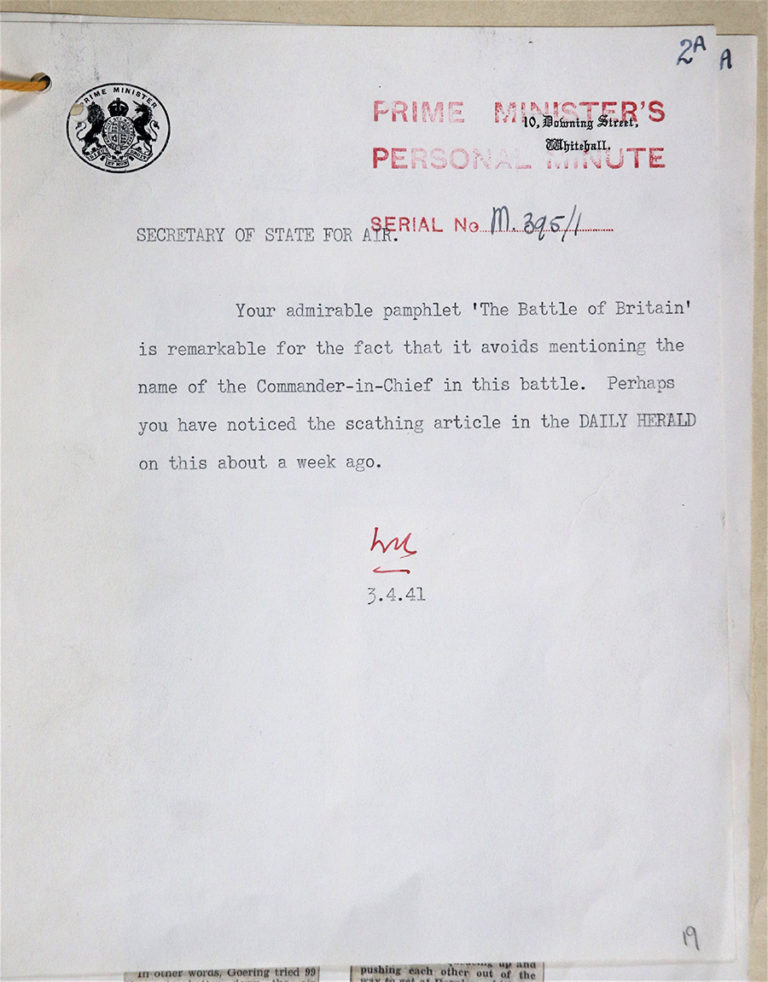The Battle of Britain occupies a powerful place in the British cultural memory of the Second World War. Between July and October 1940, RAF pilots successfully defended the British Isles against Luftwaffe attacks. Even at the time, the battle was being memorialised and mythologised through the press, propaganda and speeches. Prime Minister Winston Churchill gave a speech to the House of Commons on 20 August 1940 which included the famous line: ‘Never in the field of human conflict was so much owed by so many to so few’. This speech immortalised ‘the few’, a phrase used to refer to the heroic pilots and aircrew of the battle, more than 500 of whom were killed.
Public interest in the Battle of Britain

The Ministry of Information was responsible for producing publicity material to inform the British public about the war and to maintain morale. Through experimentation with publishing pamphlets, the Ministry had realised the importance of providing people with detailed information about the events of the war, in order to satisfy their interest and maintain a level of public trust in government.
The Battle of Britain provided the perfect opportunity to do this as curiosity about the battle was already high. The intense public interest was increased by newspaper reports and Churchill’s speech. The Air Ministry and the Ministry of Information recognised that, by actively publishing information about the Battle of Britain, they could not only inform the British people about the event, but at the same time boost feelings of patriotism, positivity about progress of the war and thus morale.
Creating the pamphlet
The Air Ministry developed a 32-page pamphlet called ‘The Battle of Britain: An Air Ministry Account of the Great Days from 8th August–31st October 1940’, which was published by the Ministry of Information. It was written anonymously (by popular author Hilary Aiden St George Saunders) and included a detailed account of the events of the battle. The account was based on official records and interviews with returning airmen[ref]Garry Campion, The Good Fight: Battle of Britain Propaganda and the Few (Basingstoke: Palgrave Macmillan, 2009), p. 281.[/ref].
Some of the most powerful mythologizing phrases of the Battle of Britain were promoted in this pamphlet. Its introductory paragraphs include a quotation from Churchill’s speech of 20 August 1940:
‘The gratitude of every home in our Island, in our Empire, and indeed throughout the world, except in the abodes of the guilty, goes out to the British airmen who, undaunted by odds, unwearied in their constant challenge and mortal danger, are turning the tide of the World War by their prowess and by their devotion. Never in the field of human conflict was so much owed by so many to so few.’
The pamphlet was sold for 3d and was a huge success. People queued outside the HMSO bookshop in London on the day of release in March 1941 and 300,000 copies were sold within a week[ref]Henry Irving, ‘Towards ‘A New Kind of Book’: Publishing and the Ministry of Information, 1939-46’, Publishing History: The social, economic and literary history of book, newspaper, and magazine publishing (2016), 75 (1). 53 – 76. ISSN 0309-2445, p. 7.[/ref].
Illustration and creative graphic design

Realising the popularity of these kinds of pamphlets, the Ministry of Information saw an opportunity to expand its work. Its Publications Division had been staffed with professionals from commercial publishing, and they drew on their experience to produce a revised illustrated edition to maximise the commercial potential of the pamphlet. Deputy Director J M ‘Max’ Parrish led this initiative, having previously worked on textbooks and encyclopaedias for publishing firm Collins[ref]Ibid.[/ref].
The new 36-page edition boasted an illustrated colour cover and eye-catching photographs, diagrams and maps. The design was innovative, and included single images printed over full two-page spreads without margins.
Parrish argued for the pamphlet to be printed with high quality to compete with commercial publishing:
‘I should be strongly inclined therefore to seek the highest quality of gravure reproduction, in retouching, etching and ink. Particularly I should say that the result must be as good as that achieved by the “Illustrated London News” if the book is to make its way with proper dignity in the open market.’ [ref]STAT 14/226, J M Parrish, ‘Ministry of Information: “The Battle of Britain”’, 28 March 1941, p. 9A.[/ref]
It was sold for 6d and within six months it had sold 4.8 million copies in the UK[ref]INF 1/123, Fraser, ‘Books and Pamphlets Programme’, 2 Dec 1941, p. 182.[/ref].
The pamphlet was licensed for distribution abroad and became even more popular. By 9 April 1942 it had been published in 43 different editions in 17 printing centres in 24 languages. It was also published in braille by the National Institute for the Blind[ref]STAT 14/226, ‘Ministry of Information: “The Battle of Britain”’, 9 April 1942, p. 110B.[/ref].

Winston Churchill’s reaction
While reactions to the pamphlet were overwhelmingly positive, Winston Churchill had one complaint. In a minute dated 3 April 1941, he wrote:
‘Your admirable pamphlet ‘The Battle of Britain’ is remarkable for the fact that it avoids the mentioning the name of the Commander-in-Chief in this battle.’ [ref]AIR 19/258, Winston Churchill, ‘’Battle of Britain’ pamphlet: correspondence’, 3 April 1941, p. 2A.[/ref]
Churchill felt that the individuals in command should have been named and celebrated specifically, rather than the anonymous approach taken by the Ministry of Information. Ministry officials responded to the Prime Minister, indicating that they disagreed with him:
‘It was deliberately decided that the pamphlet should be drafted as a plain, simple and modest account of the way in which a thousand young men – all of them anonymous – fought one of the decisive battles of the world.’ [ref]AIR 19/258, ‘’Battle of Britain’ pamphlet: correspondence’, 5 April 1941, pp. 15-18.[/ref]
These decisions taken by the Ministry contributed to the way we think about the Battle of Britain today. Rather than a battle led from the front by influential individuals in command, it is known as one fought by little-known heroic pilots, ‘the few’, ordinary men who achieved the extraordinary.

The legacy of ‘The Battle of Britain’
The obvious success of ‘The Battle of Britain’ led to the development and publication of many more ‘Official War Books’. These were designed to be high-quality, so they would be preserved, yet cheap enough to be consumed by a mass audience. The first was ‘Bomber Command’, published on 7 October 1941, which was much longer than ‘The Battle of Britain’. By 1944, the Official War Books had sold over 23 million copies, earning £30,000 per year[ref]Henry Irving, ‘Towards ‘A New Kind of Book’: Publishing and the Ministry of Information, 1939-46’, Publishing History: the social, economic and literary history of book, newspaper, and magazine publishing (2016), 75 (1). 53-76. ISSN 0309-2445, pp. 7-9.[/ref].
The story of this pamphlet is one of creativity and innovation in publishing, design, and the production of propaganda. By drawing on experiences from commercial publishing, the Ministry of Information began to produce effective propaganda material which could interest and entertain the public, while maintaining trust.
The pamphlet, and the related administrative records held at The National Archives, also offer us an insight into how the Battle of Britain was being mythologised even during the war, contributing to the development of our modern cultural memory of the Second World War.
On the Record: Untold Battle of Britain available now
To mark the 80th anniversary of the Battle of Britain we have joined forces with the Royal Air Force and the Royal Air Force Museum to make a bonus episode of our podcast ‘On the Record at The National Archives’, which is now available on the Archives Media Player and on podcast listening apps.
In this episode we are telling some lesser-known stories of those involved, including ground crew preparing the aircraft, members of the Women’s Auxiliary Air Force who bravely remained at their posts during an attack on their air base, and pilots recruited from the Commonwealth who were trained during the Battle of Britain to bolster the air force.
Subscribe: iTunes | Spotify | RadioPublic | Google Podcasts
You can also catch up on previous series in which we have uncovered the true stories of famous spies and looked at protest – from the medieval Peasants’ Revolt to Black power in the courtroom. Most recently we have marked Refugee Week, going beyond the documents as two of our records specialists interviewed their own parents about their refugee experiences.
Of course Dowding should have been mentioned and the Battle was won not due only to British pilots, but those from the Commonwealth as well and not forgetting the Polish Air Force. We should of course take the statistics with a pinch of salt, it was published in war-time of course and truth is said to be the first casualty in war.
As David points out aircraft downed was exaggerated by both the RAF and the Luftwaffe not only for propaganda purposes but through failures by both sides to estimate the numbers of fighter aircraft available to the opposing force. This wasn’t just in overall numbers but in the difference between the number of aircraft the respective fighting units of both sides and through this failure the tendency to for both RAF and Luftwaffe intelligence to assume that enemy units were constituted in the same way as ‘ours’.
He also rightly points out that it wasn’t just British-born pilots flying with the RAF – the Battle of Britain London Monument lists 2,937 pilots from 15 nations. Add in groundcrew, other RAF specialisms – including WAAF plotters, Fleet Air Arm pilots on attachment to RAF squadrons, civilians in the Observer Corps and many, many more individuals and groups and a more vivid but still incomplete picture emerges.
Turning to the post, once again the National Archives has found a different and interesting thread to unravel in what many will see as a well-viewed tapestry.
Thank you as always for doing so.
I was a child during the Battle of Britain. I lived near the Liverpool Docks. My father was in the Air Force. My home wa bombed with me and my brother and sister and Mother in it. I remember vividly the sound of the Air Raid warning, I remember the bombs whistling through the air, I remember my Mother saying Ï think this one is for us”. It was, the walls and bricks fell in on us, the “Dad’s Army” men broght stretchers with bodies on them to our area and to what was left of our house. I remember the injured child and the blood. I remember asking “why did Hitler want to kill me?”Can some German tell me?
MOI´s propagandists in Latin America printed similar pamphlets as the ones here shown. In fact, “The Battle of Britain” was an early striking success in the fiery propaganda war fought in Mexico in 1940. I keep some of these original pamphlets, as well as some others and I am planning to propose an exhibition at the local British Embassy. In the near future, I plan to write a book on British Propaganda Activities in Mexico during Worlkd War II.
George Orwell wrote a long diary entry after he read ‘The Battle of Britain’, which is available online at https://orwelldiaries.wordpress.com/2011/04/08/8-4-41/
‘But what chiefly impresses me when reading The Battle of Britain and looking up the corresponding dates in this diary, is the way in which “epic” events never seem very important at the time.’